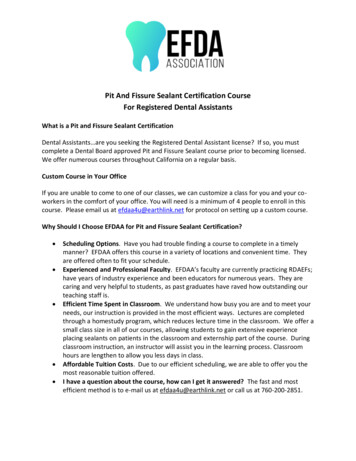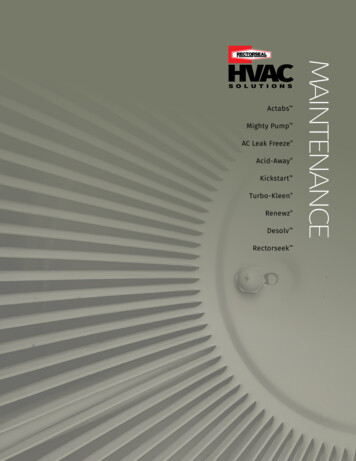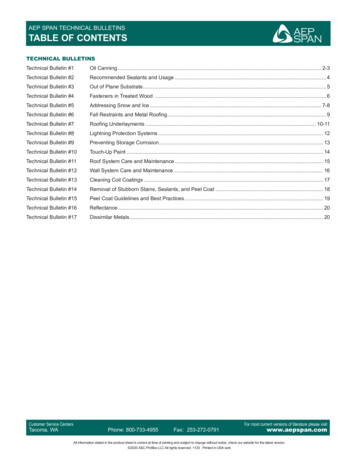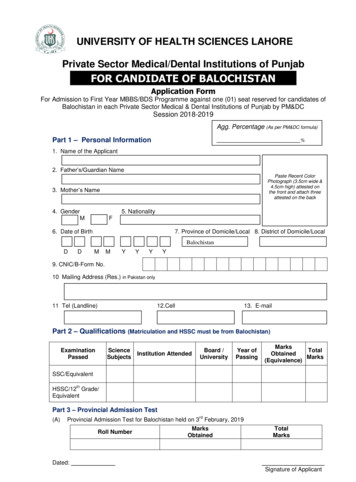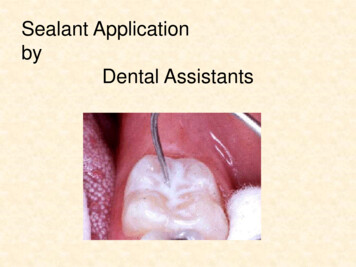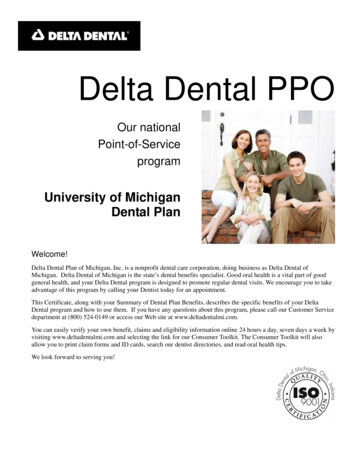
Transcription
Dental Sealants on Permanent Molars forChildren – Guidance DocumentThe purpose of this document is to provide Coordinated Care Organizations (CCOs), Dental CareOrganizations (DCOs) and dental sub-contractors, Oregon medical and dental providers, andadministrative staff with information on improving dental sealant rates for children. This document willbe updated as appropriate to reflect any changes in policy, regulation, or measure specifications.This document was updated November 2015 to reflect the 2016 measure specifications and recentlegislation.Table of ContentsIntroduction . 2What is a dental sealant? . 3Who can apply dental sealants? . 3Barriers to Sealants . 4Measure Specifications . 5Strategies for Improvement . 6Integration Strategies . 6Access Strategies. 9Non-Traditional Settings . 9School-Based Sealant Programs. 9Improve Appointment Adherence . 14Outreach Strategies . 17Provider Strategies . 20Community Coordination Strategies . 22For More Information . 22Oregon Health AuthorityDental Sealant Guidance Document – revised November 2015Page 1 of 22
IntroductionChildhood tooth decay causes needless pain and infection, and can affect a child’s academicperformance and nutrition. According to the 2012 Smile Survey1, half of children in Oregon ages 6-9have had at least one cavity, and at least one in five has untreated decay. Children from lower-incomehouseholds have substantially higher rates of cavities and untreated decay, and more than twice therate of rampant decay (seven or more teeth with decay) than children from higher-income households.Dental sealants are a widely recognized tool used to prevent tooth decay. A dental sealant is a white orclear liquid coating applied to the chewing surfaces of a child’s permanent molars. The coating flowsinto the pits and grooves where decay is most likely to occur, and seals out decay-causing bacteria.Sealants are easy to apply and can be provided in many settings. Applied and cared for properly,sealants can prevent tooth decay for up to nine years.According to the 2012 Oregon Smile Survey, 38 percent of children in Oregon ages 6-9 have received asealant on a permanent molar.2 Although this exceeds the Healthy People 2020 goal of 28 percent, aconsiderable number of Oregon children are still not benefiting from a simple and effective preventivemeasure against dental decay.In 2014, among Oregon children covered by Medicaid, the dental sealant rates for ages 6-9 and 10-14were only 11.7 and 8.6 percent, respectively. This is lower than the national Medicaid rates of 15.3percent and 10.4 percent. Note that compared to prior years, the number of eligible children in Oregonin 2014 went up considerably compared to national, which resulted in Oregon’s lower rate. See below. 32014 Oregon and National Medicaid sealant rates10.14%Ages 10-148.62%15.30%Ages 6-911.65%National MedicaidOregon dfibid3These data come from EPSDT reports, which use a slightly different methodology than the CCO incentive measurefor dental sealants (e.g., different continous enrollment criteria, etc). These EPSDT data will not match 2014baseline data reported for the CCO metric. ning-Diagnostic-and-Treatment.html2Oregon Health AuthorityDental Sealant Guidance Document – revised November 2015Page 2 of 22
What is a dental sealant?Dental sealants, also referred to as pit and fissure sealants, are a white or clear liquid coating applied tothe chewing surfaces of a child’s permanent molars. The coating flows into the pits and grooves wheredecay is most likely to occur, and seals out decay-causing bacteria.Dental sealants do not require drilling or removing tooth structure to apply. The teeth that will be sealedare cleaned and the sealant liquid is painted in the grooves of the chewing surfaces. The sealant bondsdirectly to the tooth and hardens in one minute.Sealants are not the same as fluoride varnish, or preventive resin restoration. Preventive resinrestoration (PRR) are minimally invasive fillings that are placed when very early cavities infiltrate thegrooves of chewing surfaces, but only on teeth already affected with decay processes. PRR should becoded with D1352, which could include the placement of a sealant. However, PRR does not counttoward the CCO incentive measure, and if PRR is performed, the code for sealants alone (D1351) shouldnot be used.Dental sealants are an evidence-based clinical practice and are recommended by federal agencies(Centers for Medicare and Medicaid Services; Centers for Disease Control and Prevention; U.S.Department of Health and Human Services) as well as by professional organizations (American DentalAssociation; American Academy for Pediatric Dentistry) as an effective preventive method to avoiddecay in permanent teeth in children. See the ADA’s evidence-based clinical recommendations for the use of pit and fissure sealantsonline at: pics/dental-sealants See the Cochrane review of the evidence for pit-and-fissure sealants online 1858.CD003067.pub3/abstractWho can apply dental sealants?In Oregon, the following provider types can apply sealants: Dental hygienists can determine the need for and apply sealants in certain locations and forcertain populations without the supervision of a dentist. See ORS 680.205(1) and (2) for specificlocations and populations.Outside of these locations and populations, dental hygienists require direct supervision by adentist to determine the need for and apply sealants.44https://www.oregonlegislature.gov/bills laws/lawsstatutes/2013ors680.html [see ORS 680.150 and 680.205] and OAR 818035-0030. http://arcweb.sos.state.or.us/pages/rules/oars 800/oar 818/818 035.htmlOregon Health AuthorityDental Sealant Guidance Document – revised November 2015Page 3 of 22
Expanded Practice Dental Hygienists (EPDH), those hygienists with permits to practiceindependently, can determine the need for and apply sealants, without the supervision of adentist in the locations and for the populations specified.5 Dental assistants, who hold a valid Expanded Function Dental Assistant (EFDA) certificates, canalso obtain certification in a Board-approved program to place sealants under the indirectsupervision of a dentist or an EPDH, provided the patient is examined by the dentist or EPDHbefore the sealants are placed and prior to the patient’s dismissal.6Note applying sealants via 4-handed dentistry (i.e., two providers) is a best practice.7 In school-basedsettings, 4-handed dentistry is required to ensure quality.Barriers to SealantsNationally, there are a number of barriers to children receiving adequate dental care, including dentalsealants. 8 These include: Provider reluctance to provide sealants;9Limited availability of dental providers;Low reimbursement rates;Lack of clear information for beneficiaries about dental benefits;Missed dental appointments;Transportation and child care;Cultural and language competency; andNeed for consumer education about the benefits of dental care.To improve oral health care for low-income children, a combination of these barriers must /Pages/d assist.aspx#Additional Functions of EFDA7Exploring Four-Handed Delivery and Retention of Resin-Based Sealants. Journal of the American Dental Association, March2008. http://jada-plus.com/content/139/3/281.full8CMS review of states with low dental utilization rates dental-sum-report.pdf9Sealants and dental caries: insight into dentists’ behaviors regarding implementation of clinical practice recommendations.JADA 2013;144(4):e24-e30 http://www.ncbi.nlm.nih.gov/pubmed/23543700Oregon Health AuthorityDental Sealant Guidance Document – revised November 2015Page 4 of 22
Measure SpecificationsThe Oregon Health Authority has developed specifications based on the Early and Periodic Screening,Diagnosis, and Treatment (EPSDT) Report Form CMS-416, and on the NQF-endorsed Dental QualityAlliance (DQA) measures Dental Sealants for 6-9 Year Old Children / 10-14 Year Old Children at ElevatedCaries Risk. Modifications have been made to enable CCO-level reporting, and to accommodate the lackof risk assessment data available for measurement.This measure is based on administrative (billing) data. There is only one billing code for sealants: HCPCS(or equivalent CDT) Code D1351.Sealants provided by OHA’s Oral Health Program’s School-Based Sealant Program are not encounteredand are not currently counted as part of this measure. OHA is exploring options to develop a stateregistry that will combine school-based sealant program data with Medicaid claims data for a morerepresentative sealant rate that may be used in future years.In the meantime, the benchmark for this measure has been set deliberately low to account for thesedata challenges, as well as the fact that not all children need sealants.2016 Benchmark: 20 percent, or a 3 percentage point improvement target.Numerator: Unduplicated number of children ages 6-14 who received a sealant on a permanent molartooth, as defined by HCPCS code D1351 (CDT code D1351) with teeth numbered 1, 2, 3, 14, 15, 16, 17,18, 19, 30, 31, and 32.Note: for dental sealant services submitted through medical professional or facility claims, the toothnumber information is not available on the claim form and therefore not required for inclusion in thenumerator; any sealant code D1351 submitted through medical professional or facility claims will beincluded in the numerator.Sealants can be placed in any clinical setting and by any dental professional for whom placing a sealantis within his or her scope of practice (see above).Denominator: Unduplicated number of children ages 6-14 who are continuously enrolled in aCoordinated Care Organization for the 12-month measurement year (with no more than one gap incontinuous enrollment of up to 45 days) counted as part of the denominator.Age is determined as of December 31 of the measurement year; thus, a child may have been 5 years ofage at the time of sealant placement.Note: OHA will stratify measurement and reporting by two separate age ranges (6-9, and 10-14), but therates will be combined for comparison to the benchmark and for calculating the incentive payment.Oregon Health AuthorityDental Sealant Guidance Document – revised November 2015Page 5 of 22
Strategies for ImprovementThis section provides a number of evidence-based strategies and promising practices for improvingsealant rates at both the population and individual practice level. Strategies include integration ofmedical and dental care, improving access to dental care, outreach to members, coordinating withschool-based and other community programs, and provider-focused strategies. These strategies areintended for Coordinated Care Organizations, Dental Care Organizations, and Oregon medical anddental providers to implement within their own organizations and networks.Note that school-based dental sealant programs are the only evidence-based approach at thepopulation level. Information about coordinating with school-based dental sealant programs is providedas part of the access strategy section below.Integration StrategiesDental professionals, including dental hygienists, can be incorporated into physical health or physicaland mental health co-located settings. When children are seen by a primary care provider for routinevaccinations and well-child or adolescent well visits, oral health assessments, cleanings, oral healtheducation and nutrition education, fluoride varnish, and sealants can be provided.One strategy to make best use of embedded dental professionals in medical settings is to schedule themconsistently and advertise their availability so patients know when they can see both a medical providerand a dental professional. One recommended approach is holding “Tooth Tuesdays” or other dedicatedday(s) for dental services to be offered on-site.10Note that sealants are technique sensitive and do require specialized equipment. Sealants are moreexpensive than varnish and it may not be cost-effective to embed these services in medical offices,depending on volume of patients served and economies of scale. Note also that medical providerscannot supervise auxiliary dental staff; expanded function dental assistants with additional certification(see pages 3-4 above) require dentist or dental hygienist supervision to place sealants.Another integration option is to establish dental clinics in conjunction with medical clinics. One federallyqualified health center in Boston built a pediatric dental suite in their pediatric clinic, providing moredirect and effective access to dental care.11 The FEARsome clinic, within the Waterfall Community HealthCenter in Coos Bay, Oregon is staffed by a pediatrician, a mental health therapist, and a dentist toprovide one-stop care for children in foster care.12 However, housing medical and dental services in the10Webinar: strategies to increase oral health care access to children in Medicaid: lessons from pioneering states. Center forHealth Care Strategies, Inc. Dec 2014. http://www.chcs.org/media/OHLC-Webinar-Slides 12.18.14.pdf11Oral Health Integration in the Patient-Centered Medical Home Environment: Case Studies from Community Health Centers,Qualis Health, inic-one-stop-shop-foster-kids/Oregon Health AuthorityDental Sealant Guidance Document – revised November 2015Page 6 of 22
same physical structure does not assure integration of services. Co-location requires much planning toachieve fully integrated services, with well-coordinated care and bi-directional referral systems.A recent study on integrating oral health in primary care found the drivers of successful implementationwere: Oral health champion(s) present, defined as someone motivated to make a change within theprimary care site and willing to work toward sustainability. Oral health activities delegated throughout the health care team. Oral health activities formally integrated into the work flow. Oral health prompts and questions included in the electronic health record.13Additional integration strategies include: Medical and dental providers can both promote services and schedule according to the OregonHealth Plan’s Recommended Periodicity Schedule, available online Note the Recommended Periodicity Schedule is under review to ensure the schedule provides theappropriate level of flexibility while ensuring access to needed dental services. Establishing bi-directional referral and follow-up systems. If a medical provider refers a child to adentist, structures should be in place to follow-up on the referral. Dental clinics may need to revisescheduling templates or workflows to accommodate referrals from medical clinics.It is particularly important in co-located settings or with embedded dental providers for the medicalprovider to utilize “warm handoffs” to the dental provider to ensure children are actually seen bythe dental provider. Exploring incentive programs for medical providers to refer children for sealants, or provideresources such as sealant prescription pads, to facilitate referrals. The Connecticut Dental HealthPartnership provided prescription pads to hospital emergency departments, primary carephysicians, and community agencies to facilitate referrals to dental care.14New Jersey Smiles, a Robert Wood Johnson Foundation funded Medicaid quality collaborative toimprove oral health in young children also utilized referral forms to provide families with contact13Interprofessional Study of Oral Health in Primary Care, Final Report. American Academy of Pediatric Dentistry, Pediatric OralHealth Research & Policy Center, May 2014. http://www.aapd.org/assets/1/7/Dentaquest Year 1 Final Report.pdf14Oral Health: Fighting the Number One Chronic Infectious Disease among Children. Connecticut Dental Health Partnership.May 2011. ntation%20for%20AAP%205-2011 db mm.pdfOregon Health AuthorityDental Sealant Guidance Document – revised November 2015Page 7 of 22
information for recommended dental providers.15 Identifying roles for case managers, care coordinators, or health navigators in ensuring referredchildren are able to make appointments and successfully see dental providers. Coordinating joint staff or provider meetings, or hosting retreats for medical and dental providersacross the network to strengthen collaboration and facilitate shared n Health AuthorityDental Sealant Guidance Document – revised November 2015Page 8 of 22
Access StrategiesAccess to dental care is a critical barrier. CCOs and DCOs should explore opportunities to providesealants in non-traditional settings, partner with OHA’s school-based sealant program, and adoptstrategies to address appointment adherence.Non-Traditional SettingsNon-traditional settings could include providing sealants in combination with winter flu shot clinics, orutilizing mobile sealant clinics.16 Mobile clinics can visit schools, neighborhoods, summer programs, Boys& Girls Clubs, Head Starts, and other non-traditional settings. Mobile clinics can also be a successfulstrategy for reaching rural areas, where access to dental providers may be limited. See the National Maternal & Child Oral Health Resource Center’s Mobile-Portable Dental Manual foradditional information on creating mobile / portable systems of care to serve populations in need oforal health care. http://www.mobile-portabledentalmanual.com/Other non-traditional settings could include non-profit organizations, hospitals, group homes or stateoperated facilities serving youth, and WIC clinics. Medical settings that do not provide dental services(see integration strategies above) could include community health centers, Indian Health Centers ortribal health clinics, and public health departments.School-Based Sealant ProgramsSchool-based dental sealant programs are an evidence-based practice recommended by the Associationof State and Territorial Dental Directors, the Centers for Disease Control and Prevention, and HealthyPeople 2020.17 School-based sealant programs can effectively reach children from low-income familieswho are less likely to receive care at a dental office.Oregon’s School-Based Dental Sealant Program services 1st and 2nd graders (all grades in small schools)or 6th and 7th graders (all grades in small schools). Schools are eligible if 40 percent of the students areeligible for free-and reduced-price lunches. A dental team brings portable equipment to the school,screens the participating children, and applies dental sealants as appropriate.Additional information about the program is available ntProgram.aspxOHA’s School-Based Dental Sealant Program provides a valuable service to low-income children and canbe a valuable partner for CCOs and DCOs; however it is not the only school-based dental sealant16To read more about best practices for mobile clinics based on school-based programs, see xamples/?bpareport lants.html, ves2020/overview.aspx?topicid 32Oregon Health AuthorityDental Sealant Guidance Document – revised November 2015Page 9 of 22
program! OHA is currently aware of school-based dental sealant programs operating in 35 of Oregon’s36 counties, for example: Ready to Smile in Coos and Curry CountiesKemple Memorial Children’s Dental Clinic in Deschutes CountyMultnomah County Dental Sealants ProgramOHA does not maintain a central database of all school oral health programs operating in Oregon, butthe School-Based Dental Sealant Program is willing to share any collected information. To see if anyschool-based sealant programs are operating in your area, please contact the School Oral HealthPrograms Coordinator, Laurie Johnson, DHSc, MA, RDH at laurie.johnson@state.or.us or 971.673.0339.Organizations interested in school-based oral health programs should focus on collaboration. Multipleorganizations attempting to administer programs in the same school can be confusing and disruptive.OHA recommends conducting an environmental scan, contacting OHA’s Oral Health Program, andcollaborating with community partners to learn more about what programs are offered where beforebeginning conversations with schools about new programs.School-based strategies: Research supports implementing school-based oral health programs in schools where 40 percent ormore of the students are eligible for free and reduced price lunches. If there are school-basedprograms already serving schools where 50 percent of more students are eligible, consider ways tobring these programs to other schools (between 40 – 50 percent of eligible students). While many school-based oral health programs are serving 1st and 2nd graders (sealing first molars),there are many opportunities to serve 6th and 7th graders (sealing first and second molars). If thereare school-based programs in your region, consider partnering with them to increase capacity. Note school-based oral health services should be offered to all students in eligible grades regardlessof race, ethnicity, insurance status, or socio-economic status. Organizations should base programs on evidence-based practices. Dental sealant programs canproduce a 50 percent reduction in cavities.18 Other services, such as fluoride varnish and oral healtheducation, can be beneficial additions to a sealant program, but should not replace or interfere withthe provision of sealants.18The Community Guide, 2013. Preventing dental caries: school-based dental sealant delivery portingmaterials/RRschoolsealant.htmlOregon Health AuthorityDental Sealant Guidance Document – revised November 2015Page 10 of 22
Training Organizations interested in starting a school-based oral health program must be trained in theevidence-based protocols established by the Association for State and Territorial Dental Directors(ASTDD) and the American Dental Association (ADA).19 OHA’s Oral Health Program currently offers a voluntary certification program where dental sealantprograms / organizations can be certified in providing school-based oral health services afterreceiving training and signing a Memorandum of Agreement (MOA). Certification provides schoolswith assurance that a minimum set of standards will be met while delivering services.For more information about the certification process, the MOA, or to register for an upcomingtraining, visit: www.healthoregon.org/schooloralhealth/Changes for the 2016-17 School YearSenate Bill 660, which passed during the 2015 legislative session, requires local school dental sealantprograms to be certified by the OHA Oral Health Program before dental sealants can be provided in aschool setting. Mandatory certification will be required beginning for the 2016-17 school year. The OHA Oral Health Program has convened a Rules Advisory Committee (RAC) to develop theproposed rules providing guidance for local school dental sealant programs on the requirements forcertification; application process for certification and recertification; monitoring of local schooldental sealant program; and decertification or provisional certification for programs out ofcompliance. A public comment period on the proposed rules will be available in mid-November 2015 and postedonline at: www.healthoregon.org/sealantcert/. The rules should be finalized in late January 2016. The OHA Oral Health Program will conductcertification trainings from February – August ral/schoolsealants.html, ves2020/overview.aspx?topicid 32Oregon Health AuthorityDental Sealant Guidance Document – revised November 2015Page 11 of 22
Billing and ContractingThere are multiple strategies for contracting with school-based oral health programs and billing forservices. Examples include: CCO / DCO contracts with a local school-based sealant program to provide services, paying a fixedamount for each Medicaid child served (fee-for-service), regardless of enrollment in CCO. The CCO /DCO then bills other CCOs / DCOs for their enrolled members. This approach adds administrativeburden on the primary CCO / DCO, but reduces burden on the local sealant program. Local school-based sealant program contracts with each of the CCOs / DCOs in the region, billingeach CCO / DCO separately. This approach reduces administrative burden on the CCOs / DCOs butincreases burden on the local sealant programs, especially small programs, which may not have abilling specialist. CCO / DCO contracts with OHA’s School-Based Dental Sealant Program to provide services for theirenrolled children, paying per school served. The state program cannot bill the CCO / DCO for theseservices directly, but contracts can be established.An example of a successful collaboration, leading to the transition of schools previously served by OHA’sSchool-Based Dental Sealant Program to a DCO comes from Capitol Dental.Capitol Dental hygienists and administrative staff attended a training conducted by OHA, which includedinformation regarding evidence-based practices, school protocols, and templates for school forms. CapitolDental later contacted OHA’s School-Based Dental Sealant Program to express an interest in transitioning thenine schools in Yamhill County currently served by OHA to Capitol Dental.A letter explaining the transition was approved by both organizations and was sent to the schools late in theschool year. A Memorandum of Agreement was completed. Capitol Dental hired an OHA expanded practicedental hygienist already serving these schools received technical assistance from OHA throughout thetransition, and began serving the schools directly the following school year.Capitol Dental then transitioned five schools previously served by OHA in Lincoln County. Throughout thetransitions, Capitol continues to communicate with OHA and local programs to ensure that services are notduplicated and resources are used wisely.DataIdeally, school-based dental sealant programs throughout Oregon will be standardized to ensure allprograms are evidence-based, schools are satisfied, and data and encounters are captured to meet allOregon Health AuthorityDental Sealant Guidance Document – revised November 2015Page 12 of 22
reporting requirements. Note that any sealants provided through school-based programs that are notencountered through Medicaid will not count toward the CCO incentive measure.One example of integrating community and clinical dental data comes from Advantage Dental:Advantage Dental has developed the Advanced Dental Information Network (ADIN) to integrateorganizations providing dental sealants and other preventive services in the community. ADIN is a cloudbased practice management system that allows data to be entered real time using a laptop computer ortablet with Wi-Fi capability. The community outreach function of this platform is available at no cost toorganizations that wish to use it. The only requirements are a connectivity agre
Dental sealants, also referred to as pit and fissure sealants, are a white or clear liquid coating applied to the chewing surfaces of a childs permanent molars. The coating flows into the pits and grooves where decay is most likely to occur, and seals out decay-causing bacteria. Dental sealants do not require drilling or removing tooth .
